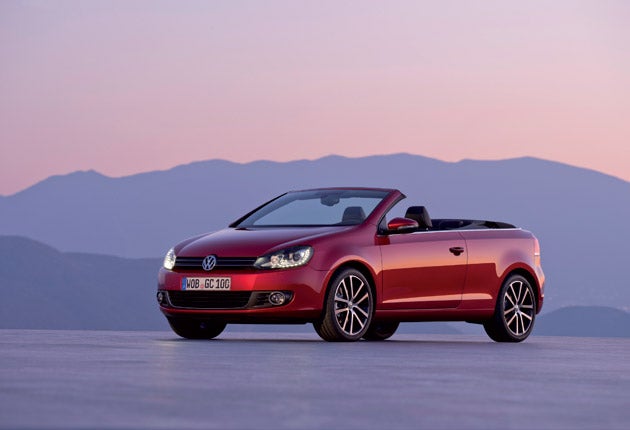Volkswagen Golf Cabriolet 2.0 TSI
Nine years after it disappeared from the showrooms, the Golf convertible has returned – and it is an impressive improvement on its Eighties ancestor

Your support helps us to tell the story
From reproductive rights to climate change to Big Tech, The Independent is on the ground when the story is developing. Whether it's investigating the financials of Elon Musk's pro-Trump PAC or producing our latest documentary, 'The A Word', which shines a light on the American women fighting for reproductive rights, we know how important it is to parse out the facts from the messaging.
At such a critical moment in US history, we need reporters on the ground. Your donation allows us to keep sending journalists to speak to both sides of the story.
The Independent is trusted by Americans across the entire political spectrum. And unlike many other quality news outlets, we choose not to lock Americans out of our reporting and analysis with paywalls. We believe quality journalism should be available to everyone, paid for by those who can afford it.
Your support makes all the difference.Where did all the convertibles go?
Squeezed out by coupé-cabriolets, mainly, because carmakers considered the lure of a hard roof able to fold away in segments to be irresistible compared with the primitive alternative of fabric stretched over a frame. More secure, too, against hood-slashing lowlife.
Whether this last part is a problem for you depends on where you park. Much more of a problem, though, is that suffered by most coupé-cabriolets, especially four-seater ones. All that folding metalwork has to be stashed somewhere when driving al fresco. That means a bulbous, inelegant tail and extra weight.
Audi doesn't believe in coupé-cabriolets, favouring a fabric roof and neat lines. Volkswagen's Golf convertible, too, always used a soft-top right from its early days as a status statement in Thatcher's Britain. Finally, in 2002 and by then very outdated, it vanished from the pricelists. What we all thought was its replacement arrived in 2006, with a new name (Eos) and, yes, a metal coupé-cabriolet roof. Volkswagen's marketing people said it wasn't an open Golf at all, but something quite different. We did not believe them.
Now, as if to say "Told you so," there is a new Golf convertible, or Cabriolet as it is known. The Eos continues, but this new fresh-air Golf has a pert neatness and economy of line the Eos can't begin to match. The waistline rises racily to a tidy, truncated tail, which contains a surprisingly generous boot.
There is proper space for four people in the cabin, and the powered roof takes just 9.5 seconds to turn the Golf from a snug coupé with astonishingly little wind noise to a wind-in-the-hair roadster.
Many people know that a Volkswagen Golf and an Audi A3 are similar cars under their differing skins. Audi makes a neat A3 Cabriolet with a similarly abbreviated tail, so it's tempting to assume that the new open Golf is simply an open A3 in new clothes. The truth is more complex.
Structurally, it has a Golf front end, an Eos centre and an A3 tail section. Various bracing bars and filled-in zones underneath help make this the stiffest-in-structure open car made anywhere in the Volkswagen group, which includes Lamborghinis and Bentleys.
This structural strength makes for a driving experience rather sharper and more sports-car-like than I expected. There is practically none of the shake and shudder over uneven roads from which too many convertibles suffer. The steering has a proper precision and proportionality of response – so the Golf goes exactly where you intend it to go. And it soaks up bumps beautifully. It's an impressive achievement.
The engine options make it lively, too, especially the 210bhp, 2.0-litre, turbocharged TSI unit which tops the range. This is the engine that best stokes the sports car impression, although some buyers might rue the lack of a normal manual transmission. A six-speed, double-clutch automatic with paddleshifters is standard fare.
However, you don't need all that horsepower to enjoy this Golf. Among the other engines available are two of exactly half the 2.0 TSI's power. One is a 1.2-litre, turbocharged petrol unit which is smooth, economical and endowed with enough torque not to struggle when hauling the Golf up hills. The other is a 1.6-litre turbodiesel which hauls harder at low speeds and is the most frugal unit in the whole range with, in BlueMotion extra-economical guise, a 117g/km official CO2 output. Both these engines have five-speed manual gearboxes with precise, easy shifts.
Whichever Golf Cabriolet you drive – the range starts at £21,000 – you'll find it windy at speed without the optional deflector, which fits over the rear seat. Reverse-parking with the roof down requires judgement and some guesswork if the optional parking sensors aren't present, because the folded hood adds height to the already high tail.
It's a lot easier than it was in the original MkI Golf Cabriolet, however, one of which was also on hand to try. This was a nostalgic encounter, with the folded hood stacked high on the rump, the body very wobbly despite a roll-over hoop between the rear body sides, but a wonderful essence of unique Golfness which made it the most covetable compact convertible of its era.
The new one replicates that essence perfectly. This time, however, it's also a proper driving machine. And after driving it, you won't want that coupé-cabriolet any more.
Join our commenting forum
Join thought-provoking conversations, follow other Independent readers and see their replies
Comments